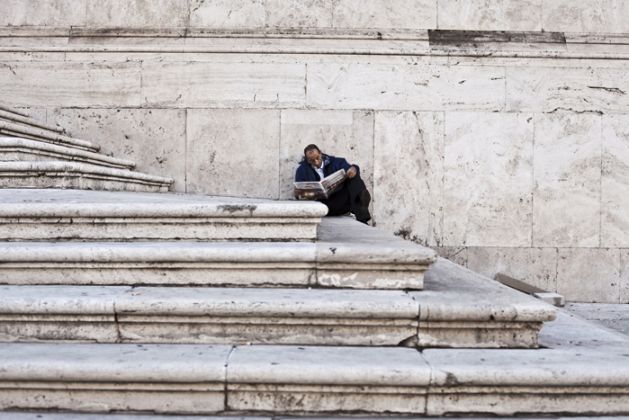In Canada and the United States, Italians form an ethnic community whose values and traditions represent an alternative to the North American status quo. This particular reality often leads to the assumption, among other North Americans that Italy, unlike Canada or the US – countries composed of plural “national identities” – hosts no minority ethnic communities of its own.
Historically, however, it is difficult to understand Italy as anything other than an amalgamation of coexisting and often conflicting nationalities. From Classical Antiquity to the Risorgimento, the Italian peninsula was the battleground of many peoples: from Gothic populations, Ottomans, and German Lombard tribes in the North, to Spaniards and Muslim peoples in the South – all competing for land, living space, comfort, commercial monopoly, and an imperial legacy. In fact, it wasn’t until the wars (from 1815 to 1871) that led to Italian unification that Italy finally ruled its own territory or could boast of a semblance of a national identity. Throughout the Middle Ages and Early Modern period, what we know today as the independent republic of Italy was, essentially a member state of a larger empire ruled alternately by Byzantine, Turkish, French, Austrian, German, and Spanish monarchs. The more or less autonomous city-states within it – Florence, Milan, Genoa, and Venice, most famous among them – were frequently in conflict, both amongst themselves and within their own city walls. Today’s native Italians, then, are both heirs of inherent civic unrest, and bred of a multicultural diversity whose vestiges are still visible in the country’s art and architecture.
Still, it isn’t difficult to imagine why Italy is perceived as “ethnically homogenous” rather than as also the home of Italian “Others“ – immigrants, children of naturalized immigrants, illegal aliens, and political refugees whose primary culture is non-Italian. Today, native Italians represent 92 percent of Italy’s population, and recent studies show that since 1975, and especially as of 1990, Italy’s status has changed from a country of emigration to one of immigration. The three-decades long mass exodus from Italy after the Second World War was followed by a period of consistent migration wherein Italy was viewed, within Europe – especially Eastern Europe – as a hospitable nation to the less fortunate suffering from war, political persecution, and widespread poverty. By the end of 2010 Italy was home to some 5.4 million foreigners. This number represents a tripling of Italy’s non-native communities over the previous ten years, and continues to climb; 2013 saw Italy’s immigrant population increase to 8.2 percent. Additionally, points of departure for this migrant flow continue to expand beyond Europe’s borders: immigration sources like Albania, Romania, Slovenia, France, Germany, Poland, and Russia have been augmented by various African and Asian nations – Morocco, Senegal, Egypt, China, Thailand, and the Philippines. Excluded from the count, but no less present in or necessary to Italy’s national functioning are illegal immigrants who are assumed to make up at least one percent of Italy’s total population (about 600,000 people).
Despite the consistent presence of resident immigrant groups on Italian soil, the relationship with mainstream Italian society is defined by exclusion and marginalization; the conversation surrounding non-native Italians is taboo. Immigrants and their families – the children born in Italian hospitals, legal residents, fluent in the Italian language and enrolled in Italian schools – are still viewed as secondary and negligible subsets of the population. Few know (or want to know) about these ethnic communities, and no one talks about them. They are conspicuously absent in the process of building or reinforcing national identity; they live in clusters outside city centres or ancient city walls; they are often deprived of basic social services available to Italian citizens; for all intents and purposes, they are made to seem physically invisible.

This lack of consideration of the “Italian Other” is nothing short of institutional and systemic discrimination. Italy declared a “state of emergency” following the massive and largely unwelcomed flux of Albanians, Somalians, and former Yugoslavians to the Italian North in the 1990s. The Dini Decree was passed in 1995, both to curb illegal immigration and to protect political refugees. But since then, laws regarding the regularization of illegal immigrants and the granting of residency to non-Italians have only grown harsher. The Turco-Napolitano Act of 1998 introduced sponsorship permits whereby foreigners were granted regularized entry into Italy to seek work if (and only if) sponsored by an Italian citizen, authority, or public entity; it also established detention centres for those migrating without such permits. In 2002, Italy’s centre-right coalition government composed primarily of the secessionist Lega Nord led by Umberto Bossi, Silvio Berlusconi’s Forza Italia, and the post-fascist Alleanza Nazionale, passed the Bossi-Fini law to further restrict the availability of and eligibility requirements for work permits. In proposing and securing a greater number of strictly temporary jobs or contract work, it also tried to discourage permanent settlement in Italy. The message behind these laws, often sustained by parties whose political platforms revolved around the sanctity and preservation of Italian national identity, was clear: foreigners were a threat both to Italian job security and to civil balance in many of Italy’s largest urban centres.
Through many Berlusconi-backed or endorsed media campaigns, foreigners also came to be perceived as a threat to social peace and national security. In many cases, and especially in Tuscany, Lombardy, and the Veneto – key regions of foreign migration – the word “immigrant” itself became associated with negative stereotypes that nurture a culture of misunderstanding and fear, and persist to this day. Despite the flimsy evidence, in the general popular mindset immigrants are believed responsible for most acts of vandalism, they are held in contempt, and they are avoided on the basis of their supposed dangerousness. (When travelling to Padua recently, I was warned – affectionately by my Italian host family – to avoid the city’s outer limits, as I might encounter unwanted attention from “violent” or otherwise disreputable immigrant populations there. I didn’t, but I almost hoped I would, so their worries would be justified.)
Some degree of discrimination against foreign populations is the result of the inability or unwillingness (perceived or real) of these populations themselves to adapt to or assimilate Italian practices. But this too may be a consequence of their continued marginalization from Italian society. With Berlusconi’s re-election in 2008, a number of public sector institutions and NGOs, most of them voluntary, have aimed at reversing the stigma surrounding foreigners and at filling the gaps in public services by the Italian government. Refugees and irregular immigrants are afforded Italian language classes and basic health care, in spite of the fact that school and hospital authorities not only close their doors, but often denounce their presence.
But discrimination against non-native Italians persists. Local “policies of exclusion” are enacted with the express purpose of alienating foreign populations by withholding from them services or means otherwise available to natives. For example, they are denied social services on the basis of income and level of employment; they are limited in their possibilities of owning or operating “ethnic” enterprises; they are refused the opportunity to open or frequent places of alternative (non-Catholic) religious worship; and are prohibited from hosting extended public gatherings with members of their communities. They are made to both feel and despise the role of Outsider attributed them. As a result, the members of these “transnational” communities, with social ties both to their country of origin and to their host country, establish feeble links with the Italy that receives them.
But integration eventually takes root, encouraged by sustained residency and a number of other predictable factors: romantic interactions with native Italians; the growth of a family; social and professional achievement. Still, the transition from Outsider to Insider remains long and arduous.
Beyond stereotypes of violence and civic unrest, when Italian immigrant populations are considered at all, it is as an economic entity viewed, paradoxically, as both parasitic and necessary. With a steadily decreasing birth rate – between eight and nine births per 1,000 people – Italy has ranked 207 out of 221 countries surveyed since 2001. It is still wrestling with an economic crisis now half a decade old. As a result, immigrants and their children represent an additional workforce that, from a popular perspective, both supplements and endangers native Italians’ livelihoods. On the one hand, many immigrant workers, especially women, replace formerly “surplus” Italian populations from the south, holding low-wage positions that are undesirable to formally-educated Italians; they work in the domestic sphere as maids, babysitters, or caregivers to the elderly; they provide services to a segment of the population that in many ways fails to care for its own. They subsequently shrink labour shortages, aggravated by Italy’s low birth rate and politics of welfare for the elderly. On the other, and with the increasing popularity of ethnic retailers and the consequent depreciation of the “Made in Italy” philosophy and brand, they constitute an alternative to Italian models of production and dissemination appreciated by buyers for their often more affordable pricing, but disdained for their competition with local and national manufacturers.
A particularly salient example is the Chinese. Alongside their Japanese neighbours, they have established themselves as reputable businesspeople in major urban areas in Northern and Central Italy – in cities like Milan, Florence, Venice, and Rome. Chinese immigrants and naturalized Chinese-Italians make up 6.32 percent of Prato’s population – Italy’s largest concentration of Chinese immigrants. Most are local entrepreneurs and own clothing shops that market trendy items at a fraction of the cost of their higher-quality designer equivalents; or they operate restaurants that compete with emblematic Italian trattorie, both in price and quality. Their establishments are frequented by Italians, mostly young, who go “dal cinesino” (to the Chinese man’s shop) to indulge in their hobbies without damaging their own meagre incomes. To any Italian, however, this alternativeto the Italian status quo is still the less prestigious, inferior choice. In fact, most youths admit to shopping dal cinesino in tones of resigned remorse: Se non hai soldi, dal cinesino si trova (if you can’t afford the real thing, go to the Chinese man’s shop).
Of course, it isn’t all bad news. Since 2013, Berlusconi’s absence (at least theoretical) from the Italian Parliament has left a larger space to Italy’s pro-integration forces – and they do exist! Mostly the product of a younger generation of left-wing Italians with international exposure and experience (for example, from the study-abroad “Erasmus” program), these initiatives aim both to underline and valorise cultural diversity in Italy. They take various approaches. A recent print media report aimed to demystify the migrant Rom populations – Romanians commonly referred to as “gypsies” escaping political turmoil and living as nomadic groups outside Italian cities. Television shows, and more frequently, Italian reality TV, have been making concerted efforts at diversifying their casts and, in some cases, even favouring non-Italian cast members; Master Chef Italia Season 3 (2014) prominently featured Senegalese Emma and Moroccan Rashida, both of whom graduated to the show’s more advanced rounds. With the superstardom status of Mario Balotelli, multicultural discourse has even made its way to the pitch. Italian players from all clubs, well accustomed to playing with players of all races, have begun to routinely denounce racist practices, referees, and stadium policies. In many Italian elementary schools, students may opt out of religion and catechism classes, a new-found respect for non-Catholics. The face of foreign accommodation is starting to change.
At the human rights level, the Italia sono anch’io campaign perhaps best sums up Italy’s changing attitude toward foreign cultures and immigrant populations. This campaign, created and supported by 22 social service organizations, posits two specific ends: first, the granting of citizenship to children born in Italy to regularized immigrants; and next, the granting of the right to vote to immigrants who have been working in Italy consistently for at least five years. If achieved, these goals would at least ensure that immigrants’ voices are heard in local and national elections, and they would provide second-generation Italians with the same rights and protections as their native Italian counterparts. The campaign website also addresses issues of racism and discrimination more generally, and popular support has increased steadily since its creation some five years ago. More and more, as Italians both acknowledge and accept the economic usefulness of their immigrant “guests,” they have come to appreciate the different perspectives they bring to the Italian table, and understand the need to make permanent space for them there.
It will take some time before Italy begins to imagine itself as an American melting pot or a Canadian tossed salad of various ethnic influences. It will take the rest of the world longer, still, to see Italy as a place of equal opportunity for multicultural groups. Still, it behooves Italians and visitors to Italy alike to remember Italy’s roots as a host nation first. Italy’s national fabric has been woven of multicoloured threads and enriched by the presence of cultures it has considered foreign to its own – now as in the past! It is a fact worth remembering, as Italy moves from accommodation to acceptance and praise of the Italian Other.
Tania Zampini is a native Montrealer of Italian descent. She holds a Ph.D. in Italian language and literature from Johns Hopkins University. She currently lives in Florence, where she writes and teaches.



